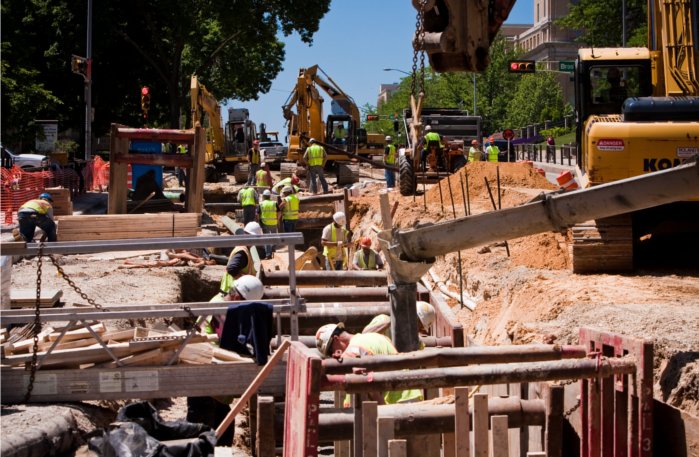December 2009 Vol. 236 No. 12
Features
Major Wisconsin Project Succeeds Despite Constricted Conditions

Big Ten football equals crowds and traffic in the heart of Madison, WI. About 80,000 people poured into Camp Randall for the opening football game for the University of Wisconsin Badgers on Sept. 5.
Many of those fans traveled down University Avenue, where just a few weeks earlier construction crews were laying multiple utilities in a single trench.
Throughout the street reconstruction project, a strict deadline loomed because the City of Madison and University of Wisconsin were adamant that University Avenue open in time for football season.
That deadline was met – but it was not without challenges.
Tight Deadline
In October 2008, utilities were given an eight-month notice that the City of Madison was reconstructing University Avenue, a major thoroughfare from the downtown through the campus.
The local combination utility, Madison Gas and Electric Co. (MGE), quickly evaluated its needs. MGE notified the city that it wanted to reinforce its downtown natural gas system and add major underground electric distribution lines to meet future customer demand. Both of these installations are significant energy feeds for Madison and the metro area.
MGE generates and distributes electricity to 137,000 customers in Dane County, WI and purchases and distributes natural gas to 141,000 customers in seven south-central and western Wisconsin counties. MGE is the principal subsidiary of MGE Energy.
Then, American Transmission Co. (ATC) said it was essential that an underground electric transmission pipe be added for future load growth. ATC owns, operates, builds and maintains the high-voltage electric transmission system serving portions of Wisconsin, Michigan, Minnesota
and Illinois.
By December 2008, the city reviewed the utility infrastructure needs and the looming deadline. Its engineers – working with MGE and ATC – came up with a solution. The only way the work could progress on schedule was if gas, electric distribution and electric transmission shared one trench and worked simultaneously.
Tight Spaces
This may have been the first time in Wisconsin that these major types of utilities shared one trench.
Due to utility construction work, traffic flow was reduced to one or two lanes on University Avenue. Heavy downtown vehicle traffic backed up and crawled past workers. Students on foot, bikes and mopeds zipped through the area. Getting construction equipment in and out of the area was difficult.
Another aspect of the project was a directional bore required under the adjacent State Street – a popular campus retail/entertainment district. The 900-foot bore was 22 feet below the street with 300 feet of lay-down area. This side project was challenging due to the constricted spaces and the many students that frequented the area.
Going into the project, all the parties involved knew that the combination of tight deadlines and spaces would require excellent coordination.
MGE took the lead on the utility work. ATC contracted with MGE to head the construction of transmission facilities.
MGE then turned to its primary contractor—KS Energy Services—to do all the construction work. KS Energy is a provider of natural gas, electric and telecommunications construction services in the U.S. Joining the project as a subcontractor was InterCon Construction Inc., which installed the ATC facilities because it specializes in high-voltage underground utility installations.
“The success of this complicated project began with solid relationships,” said Dennis Klumb, president and CEO of KS Energy Services.
John Yogerst, MGE’s Assistant Vice President of Gas Operations, agreed: “MGE and the City of Madison have a long history of working well together. Additionally, KS Energy and InterCon have a good working relationship with each other and with MGE. We knew we could pull together to do quality work and meet the deadline.”
It took six months of meetings to prepare for eight weeks of work. For complicated projects, planning ahead is essential to smooth coordination once workers hit the trenches.
Success Is In The Details
- Before the bidding process, partners worked closely with the City of Madison so its street contractors were well prepared. Digital files were shared with the city. MGE and ATC had routes marked and inserted into the City of Madison’s CAD file as individual layers and incorporated into the city’s plan set for bidders.
- A narrative describing each utility’s facility and route was included in the city’s specifications. Each prospective bidder was aware of the scope of the utility construction and could bid and plan accordingly.
- MGE and ATC worked with a third-party consultant to develop a new design, including a fluidized thermal backfill, so the distribution and transmission could be separated by a three-foot allowance rather than the standard six-foot allowance.
- Meetings with ATC determined trench cross-sections for various trenching scenarios.
- Coordination was key. Weekly meetings were held between MGE, KS Energy and InterCon to prepare for upcoming construction. Partners also held weekly scheduling meetings with the City of Madison and its contractors.
- Individual coordination sessions helped resolve specific issues that kept the flow of pedestrians, vehicles, trains, construction equipment and business deliveries moving.
- The City of Madison was just one of the entities. The partners also worked with Wisconsin’s departments of Administration and Transportation, the University of Wisconsin Facilities Management, Wisconsin & Southern Railroad and local business owners associations.
“The University Avenue reconstruction was one of the most difficult projects in the history of KS Energy Services,” Klumb said. “We successfully met the deadline due to the detailed planning and coordination that made this a team effort. From the top down, there was cooperation from the engineers, surveyors, supply chain, construction companies, utilities and other partners.”





Comments